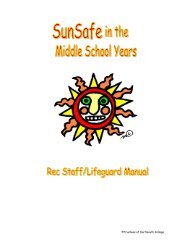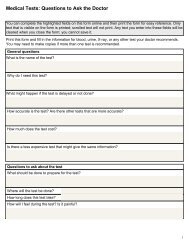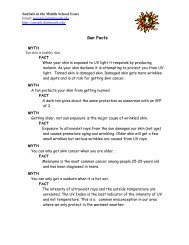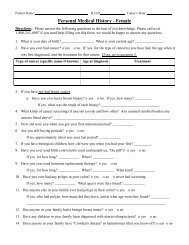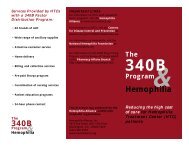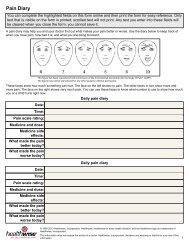Detecting UV Light Using Tonic Water
Detecting UV Light Using Tonic Water
Detecting UV Light Using Tonic Water
Create successful ePaper yourself
Turn your PDF publications into a flip-book with our unique Google optimized e-Paper software.
Science SunSafe in the Middle School Years<strong>Detecting</strong> <strong>UV</strong> <strong>Light</strong><strong>Using</strong> <strong>Tonic</strong> <strong>Water</strong>Estimated Time40 – 50 minutesSuppliesTwo beakers, labeled “tap water” and “tonic water”<strong>Tonic</strong> waterTap waterBlack paper or clothSunlightLearning ObjectiveThis activity will demonstrate the presence of <strong>UV</strong> light in sunlight.When a photon of <strong>UV</strong> energy is absorbed, it is re-emitted by thequinine in tonic water as a photon of visible light. This process iscalled fluorescence. The amount of fluorescence that occurs isinfluenced by the amount of <strong>UV</strong>. This will reinforce the concept that<strong>UV</strong> light is always present in sunlight, although invisible to the nakedeye. Have students write a paragraph explaining what has happened inthis experiment, using the following words: fluorescence,wavelengths, photon. The students should demonstrate the ability toresearch scientific background for a certain phenomenon. Studentsshould show comprehension of the idea that it is the size of the <strong>UV</strong>wavelengths that cause them to appear invisible, but that when aphoton of <strong>UV</strong> energy is absorbed in the tonic water, the quinine reemitsthe energy as a photon of visible light.DirectionsFill the beaker labeled “tonic” almost to the brim with tonic water.Fill the other beaker almost to the brim with tap water. Place thebeakers outside, so that direct sunlight strikes the surface of theliquid in both beakers. Ask the students to predict what they mightobserve. Hold a black piece of paper or cloth behind the beakers.Have the class look across the surfaces of the two beakers.Questions and Answers1. What differences do you see? The top ¼ inch of the tonicwater should glow blue.2. What time of day is it? Where is the sun in the sky?Answers will vary.3. How might the position of the sun affect your results? Bestresults occur around noon when the sun is directlyoverhead. The higher the sun is in the sky, the shorter thedistance the <strong>UV</strong> light must travel through the ozone layer,allowing more <strong>UV</strong> radiation to reach the Earth’s surface.4. What is contained in the sunlight that causes these results?<strong>UV</strong> radiation. Students should grasp the concept that <strong>UV</strong>light is always present in sunlight.
Science SunSafe in the Middle School Years<strong>Detecting</strong> <strong>UV</strong> <strong>Light</strong> <strong>Using</strong> <strong>Tonic</strong> <strong>Water</strong>DirectionsIn this activity, you will use tonic water to do an experiment withultraviolet light. Fill the beaker labeled “tonic” almost to the brimwith tonic water. Fill the other beaker almost to the brim with tapwater.Place the beakers outside, so that direct sunlight strikes the surface ofthe liquid in both beakers. Hold a black piece of paper or cloth behindthe beakers.Observe the surfaces of the tonic and tap waters in the two beakers.Answer the questions.Wavelength – In a periodic wave, the distance between two pointsof corresponding phase in consecutive cycles; a measurement oflight/radiation.Questions1. What differences do you see between the two beakers?2. What time of day is it? Where is the sun in the sky?3. What is contained in the sunlight that causes these results?Vocabulary WordsFluoresce – To exhibit fluorescence (luminescence) caused by theabsorption of radiation at one wavelength followed by nearlyimmediate reradiation usually at a different wavelength, and thatceases almost at once when the incident radiation stops.Ultraviolet light – Of or pertaining to the ultraviolet spectrum ofinvisible light/radiation.* This activity is adapted from the Project LEARN module Ozonein Our Atmosphere.



